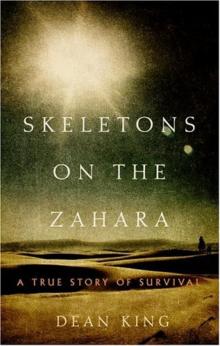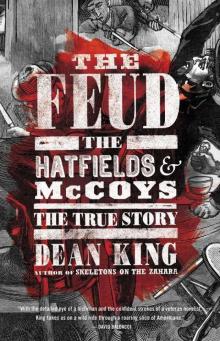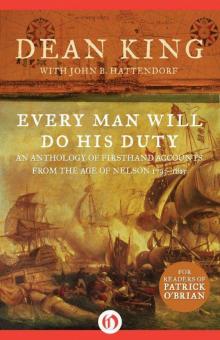Skeletons on the Zahara Read online
Page 2
Early that evening, in the exhaustion and despair after the bloodbath, Hamet decided to gather his friends and leave Haherah on his own. He had been made a captain in his previous caravan and knew how to navigate the desert. He and his wounded brother spread the word among their allies to quietly prepare to depart that night. Hamet and Seid killed four of their six remaining camels and fed their blood and water to the two strongest. Hamet packed as much of their barley and merchandise as they could reasonably carry, for they could not arrive at Tombuctoo empty-handed.
Around midnight, Hamet led thirty men and thirty-two camels silently out of the valley into the inky, cloud-dark night. The plain roared with Allah's thunder as they went, but no rain fell.
North of the Niger River in the land Seid and Hamet called Soudan (now Mali), the merchants of Tombuctoo searched the horizon anxiously for the season's caravan. The famous walled city brimmed with fresh stores of gold and slaves to be exchanged for the goods they coveted from the far side of the great void. Once a seasonal camp of the central-Saharan Tuareg nomads, Tombuctoo had risen to prominence in the fourteenth century as the continent's chief marketplace and a locus of African Islam, with learned men and fine books. But its riches also made it a target, and it was sacked by Moroccan invaders in 1591, precipitating a slow but steady decline. Nonetheless, two centuries later, the caravans still came and were sometimes even larger than the one Hamet and Seid had set out in. When the brothers' small company finally limped into Tombuctoo, a total of twenty-one men and twelve camels had survived. They were weary, starving, broke, and alone. No one from their once mighty caravan had preceded them and no one followed.
It was a land of much hardship, and there was little remorse to spare for lost foreigners and even less sympathy for those who had had the fortune to be spared by Allah. The king of Tombuctoo conscripted Hamet, Seid, and ten of their companions and dispatched them in a caravan into the interior. They worked for nearly a year, each earning two haiks and some gold, and then joined a caravan of merchants from Algiers, Tunis, Tripoli, and Fez, returning to the north with turbans, ivory, gum, gold, and two thousand slaves.
On the deep desert, a large party of Tuareg, the Sahara's most feared raiders, armed with muskets, spears, and scimitars, had lain waiting for them for months. They attacked quietly at night, holding their fire until the last minute and then pouring a furious storm of musket balls into the circled-up caravan. Hamet took one in the thigh. One of the Tuareg stabbed Seid in the chest with a dagger. The caravaneers fought for their lives. The raiders killed 230 men and wounded many more before being repulsed, but both brothers survived. Seid assuaged his anger by helping himself to one dead raider's fine musket.
Two years after they had set out in Sidi Ishrel's grand caravan, Hamet and Seid returned to Wednoon with one camel and a trifling amount of merchandise. Sheik Ali had once again failed to profit. This time, he cast Hamet and his brother out onto the Sahara with bundles of haiks and blue cloth to trade with the fierce Kabyles, the desert tribes who raised and raided for camels, hunted ostrich, and on occasion salvaged shipwrecks. Ali had instructed the brothers to trade for ostrich feathers to sell in Swearah or Morocco.
Hamet and Seid wandered south some three hundred miles. One sweltering late-September afternoon in 1815, they spied a cluster of worn-out tents and decided to seek shelter from the sun. They rode into the camp, where to their surprise, they discovered among some Arab women two Christian sailors. One of them was the captain of a merchant ship that had wrecked on the shores of Cape Bojador.
Through his deference to them and his overriding concern for his men, the captain quickly demonstrated that he was a brave and worthy man, no matter how diminished by the Sahara. He approached them with a proposition: He would pay them many pieces of silver if they would render him and his crew, who were scattered nearby among the nomads, a service. But, the brothers knew, the service was as risky as a donkey's trek through a lion's den. It would require that they invest all their goods and then travel across hundreds of miles of hammada, dunes, and Atlas foothills. The sailors, frail from thirst, starved, and flayed by the sun, might all die or be stolen before they could be ransomed.
Most of all, Hamet and Seid worried about being cheated in the end. Could they trust a kelb en-Nasrani— a Christian dog? Did they dare risk disappointing Sheik Ali again?
Sidi Hamet prayed to Allah for guidance.
PART ONE
Acts of God
chapter 1
A Good Yankee Crew
On a brisk early-May morning in 1815, when Captain James Riley gave the order to cast off from Savage's wharf in the Upper Houses section of Middletown, Connecticut, he had ten men attuned to his every word. "Jemmy Madison's War," a war that New Englanders had bitterly opposed and that had ruined many merchants and left the majority of sailors stranded on shore, was over at last. It was time to get back to work.
Clad in the Connecticut seaman's traditional garb— linsey-woolsey or canvas duck trousers and shirts and snug-fitting round-brimmed hats of tarred canvas or leather— the crew of the 220-ton brig Commerce set sail. As those aloft balanced on "horses," the tarred ropes running beneath the yards, they unfastened buntlines, sending the canvas cascading into place. Those on deck hauled and coiled lines. Gruff voices and hammer taps from the now-busy shipyards followed them out on the chilly Connecticut River. The Commerce swung around into the channel, and the current, swollen by New Hampshire and Vermont snowmelt, swept them along at five knots back to sea. Now they could look wistfully at the banks they were so desperate to leave. The voyage would take them first to New Orleans and then, if the peace held, across the Atlantic to Gibraltar and partway down the west coast of Africa to the Cape Verde Islands for salt to bring back to Connecticut. If all went well, they would be home before the end of the fall harvest. The wages they earned would help settle overdue accounts.
Captain James Riley
(from An Authentic Narrative of the Loss of the American Brig Commerce, 1817)
The Connecticut—"long tidal river" in the Algonquian tongue— stretches 410 miles from Canada to the Long Island Sound. The river's final 64 miles, from the fall line at Windsor to its mouth at Saybrook, constitute the Lower Valley, a center of shipbuilding and commerce with the West Indies since the Puritans had settled there almost two centuries earlier. But throughout the recent war, it had been bottled up tight.
Lifelong sailors like the Commerce's first mate, George Williams, who hailed from a steady line of sea captains, had chosen to cast about on shore for odd jobs while waiting out the war. The youthful able seaman Archie Robbins, on the other hand, had taken his chances against the Royal Navy, and as a result had turned twenty-one and twenty-two in a Halifax prison. Second mate Aaron Savage, twenty, was the son of a prominent merchant and part-owner of the Commerce. Like Williams, Savage had worked on shore, forfeiting crucial years of sea experience. By the time he was that age, Riley had already risen through the ranks in Lower Valley shipping and moved to New York to take command of a vessel in the trans-Atlantic trade.
Now a bearish man of thirty-seven, Riley had been a mariner for twenty-two years. When he was only eight years old, he had been hired out by his father, a poor and ailing farmer, to a neighbor to earn his keep helping with the crops and tending livestock, chores he found especially miserable on frigid winter mornings before the sun rose. At fifteen he escaped to sea. Determined never to return to the farm, he had quickly learned to reef, steer, and navigate. Riley had risen to captain in just five years.
He had most recently been captain not of a ship but of a volunteer company of artillerists, composed mostly of merchant sailors and officers, who had elected him their leader. Riley and his volunteers had grown tired of the British harassing American vessels and impressing her sailors, which had gone on sporadically for more than a decade. But President Jefferson's ill-conceived retaliation in 1808, the Embargo Act, prohibiting exports from the United States and stopping U.S. ships from enteri
ng foreign ports, had backfired. American seamen had been cast ashore. Many merchants had failed.
Other missteps had followed, and President Madison had nearly finished off the Yankee merchantman when he declared war on Britain in 1812, bringing on the Royal Navy blockade of the U.S. coast. The value of American exports had plummeted from $60 million in 1811 to $7 million in 1814. Between 1808 and 1813, one Connecticut merchant, John Williams of Wethersfield, had lost five vessels, including his sloop Merino, which the British took off Saybrook in 1812 and burned at New London.
In 1814, after the British had torched twenty-eight vessels at Potapaug (now Essex), near the mouth of the Connecticut, and gone on to sack Washington, burning the Capitol, the White House, and many other public buildings, and then, as Riley put it, "loudly threatened to destroy every assailable place on the seaboard," Riley had felt the call to defend his country. He helped form the artillery company, which had forty-four members and, if needed, could muster half that number again within two days if needed.
However, in January 1815, before his company could be deployed, news of the Treaty of Ghent had arrived, putting an end to the conflict if not exactly achieving America's goals of "sailors' rights and free trade." For himself, Riley hoped, it had also put an end to a run of bitter luck.
At eighty-six feet long and twenty-six feet in the beam, the Commerce was designed not for river traffic but for the sea. Her two masts of resilient Valley pine towered over the brig's single-decked oak hull. She was square-rigged on both masts but instead of carrying a course on the mainyard had a large fore-and-aft sail rigged out on a boom, making her a more versatile sailor than pure square-riggers. Her dark-painted hull was a bit more than eleven feet deep and roomy enough to hold sixteen hundred barrels. In addition to a crew of eleven, she currently carried what Archibald Robbins called "a small cargo"— twenty tons of hay— though she was also ballasted with 25,000 bricks, which would be sold in New Orleans.
In the early morning light, as a wake formed behind the brig on the surface of the ten-foot-deep pool, the men took a last look at Upper Houses, a prosperous mariner's village of eight hundred, which was technically a section of Middletown but was separated from it by marshland and the Sebethe River. The illustrious Savage family, among others, had built and dispatched merchant ships here for decades. Two new vessels, a brig and a sloop, sat on the stocks nearly ready for launching.
The crew bade farewells to no one but a few hands from the stores and wharves of Josiah Savage, one of the brig's owners. Savage also owned or had interests in a smithy, a ropewalk, and a slaughterhouse. His men butchered and salted hogs and cattle, packed them in barrels made at his cooperage, and rolled them onto his merchant vessels. The Commerce slid past the row of sea captains' silent clapboard houses, many built for various Savage brothers, a testament to the village's seafaring success.
In the Commerce and other endeavors, Josiah Savage and his brother Luther were partners with Captain Riley's uncle Justus Riley, of Wethersfield, at seventy-five still an active merchant. Josiah and Justus had prospered together ever since Josiah, now fifty-five, had commanded several of Justus's West Indies vessels and then bought shares in others. The two were cut from the same steel. Shrewd and resourceful, they had been tempered in the Revolutionary War. Justus had captained a privateer and fought alongside half a dozen other Rileys, all adept at that opportunistic, nettlesome mode of warfare. For his part, Josiah had enlisted in the Continental Army as a teen and, alongside his brothers and father, seen plenty of action. After one fight that killed most of his company, Josiah had been stripped of his clothes and forced to run a Mohawk gauntlet, where he had been kicked, clubbed, and beaten in a ritual meant to punish strong men and kill the weak. Josiah was not weak.
Neither was James Riley. Both Justus and Josiah knew a trustworthy man when they saw— or hired— one. They had great faith in Justus's nephew. They liked his intelligence, his industry, his no-nonsense attitude, and— not least— his massive frame. At six foot one and 240 pounds, James Riley was a good man to have on your side. He was athletically built and powerful by nature, augmented by years of hauling hay and hoeing fields as a youth. Having worked his way up through the ranks, he understood not only his vessel but also the hearts and minds of sailors.
At forty-eight, first mate George Williams was the most experienced seaman on board, a man who could navigate and stand a watch, giving the captain time below in complete security. Williams, whose aunt had married a Riley, had a wife and family in nearby Wethersfield. He was the dependable grandpappy of the crew, linked to the men by family ties, loyalty to their captain, and a shared faith in the sea.
Josiah Savage figured that his third son, Aaron, could learn much by sailing with Riley and Williams, and he had a knack for putting his sons in a position to succeed. His eldest would go on to help found the Aetna insurance company. Another grew immensely wealthy financing the railroads, and his next-to-youngest, a Yale-educated priest and the first Episcopal missionary to Africa, was later credited with discovering the gorilla. Aaron would learn his father's business from the water up.
Captain Riley had taken another Savage on board as well: Horace, the son of William Savage, Josiah's youngest brother and a close friend of Riley's. William had gone to sea in a coasting schooner in November 1799, the year Horace, his second son, was born, and never returned. Ever since, Riley had felt a responsibility to protect the boy and ensure his success. On this trip, the fifteen-year-old would be his cabin boy.
From the brig's flush quarterdeck, Riley could see his former home on Prospect Hill at the top of Main Street. It looked down on Upper Houses and as far as Lamentation Mountain and Mount Higby to the west and southwest. On a tour of the Valley in 1771, John Adams had stood on what would become Riley's property and taken in the view. "Middletown, I think, is the most beautiful town of all," he later wrote in his diary. "When I first came into the town, which was upon the top of a hill, there opened before me the most beautiful prospect of the river, and the intervals and the improvements on each side of it, and the mountains, at about ten miles distant." Adams admired the surrounding fields and small farms with loam "as rich as the soils of Egypt."
In 1807, when everything was going his way, Riley had bought No. 33 Prospect Hill Road, built half a century earlier by Deacon Ranney. The large two-and-a-half-story clapboard house on a foundation of cut brownstone came with fifteen acres of land and gave his growing family plenty of elbow room.
But hard times had forced Riley out of that house and into humbler lodgings. He could picture his pregnant wife, Phoebe, still asleep in their warm bed there. He was disappointed that their fifth child had not arrived before he sailed, but unfortunate timing was often the lot of the sailor, and there could be no delay. Three long years had passed since he had last set sail, and more than twice as many since a run of profitable voyages had made him temporarily wealthy. There was no more time to lose, not even a day.
Phoebe, the daughter of Hosea Miller, a local Revolutionary War veteran, bore her fate well. She had watched her husband, a passionate man with wide-set eyes and thick dark eyebrows, struggle and brood ever since returning home at the beginning of this recent war. He had been unable to find a position in the Navy. He had no funds to outfit a privateer vessel, and he refused to engage in the lucrative illicit trade with the enemy in Canada or the West Indies, unlike many sailors in New England, a region that opposed the war. Nor would he conduct trade under false colors, trade that necessarily evaded the authorities on both sides of the conflict and was thus against the law.
While he was away, Phoebe would have her hands full with their children— ten-year-old James, Amelia, six, Phoebe, two, Horatio, thirteen months, and a newborn— but she would have help.1 Upper Houses was a tight-knit community, and James's two spinster cousins, Ann and Eleanor, lived nearby. When their brother, Julius Riley, had sold the place on Main Street in 1784, the new owner agreed to allow the sisters to stay on the third floor until they ma
rried. In what was perhaps a case of extreme Yankee thrift, not only did neither ever marry, they both lived to be more than a hundred.
One of the Middletown newspapers, the Middlesex Gazette, recorded the Commerce's departure from Middletown on May 2, under a clear sky, with winds blowing providentially from the northwest, and the temperature rising in the afternoon to sixty-two degrees. Two miles south of Savage's wharf, the Commerce slipped past the shipbuilding center Chatham on the east bank, which along with Upper Houses was considered part of greater Middletown.
To the north, through fifteen miles of wide floodplains, the river was regularly dredged to Hartford for sloop navigation— vessels drawing eight feet of water or less. Larger vessels drawing up to ten feet of water could reach only as far inland as Middletown, where the federal government, in 1784, had established one of the state's four customs houses to track the profitable sea trade. While Valley ships often ventured across the Atlantic, as the Commerce was about to do, trade with the West Indies prevailed.
The Valley's merchants, shipbuilders, and farmers worked together in a lucrative partnership, the farmers raising livestock on fields of clover, timothy, and other grasses and shipping to the West Indies butter, cheese, beef, and pork, along with such crops as corn, rye, oats, and potatoes. They also sent horses, which were tethered on the decks of vessels nicknamed "horse jockeys," and lumber, especially oak barrel staves, which were essential for transporting the islands' sugar. Their ships returned from the islands carrying sugar, salt, coffee, indigo, and rum, as well as manufactured and luxury items from Europe. Until 1790, when it was outlawed, some Connecticut vessels also came home with slaves, who in this part of the country mostly worked as domestic servants.

 A Sea of Words
A Sea of Words Skeletons on the Zahara
Skeletons on the Zahara The Feud: The Hatfields and McCoys: The True Story
The Feud: The Hatfields and McCoys: The True Story Every Man Will Do His Duty
Every Man Will Do His Duty 9/11...The Tragic Story of the Day that Changed America: The Terror, The Horror and The Heroes
9/11...The Tragic Story of the Day that Changed America: The Terror, The Horror and The Heroes White Slave Cop
White Slave Cop Skeletons on the Zahara: A True Story of Survival
Skeletons on the Zahara: A True Story of Survival